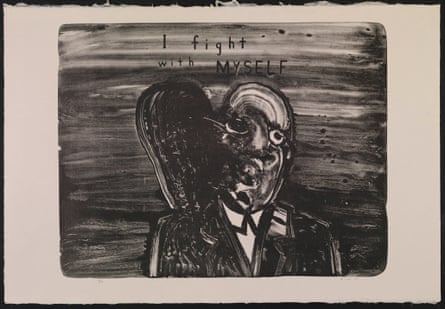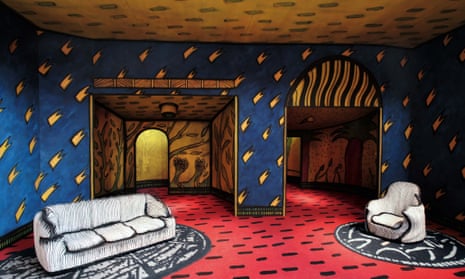The entry to David Lynch: Between Two Worlds at Brisbane’s Gallery of Modern Art is through a portal. On the gallery wall is a small drawing of a violently carpeted lounge room, with an armchair and a couch, flock wallpaper and rooms that disappear beyond in forced perspective. Right next to the drawing is a full-scale rendering of the scene, a three-dimensional rendition that’s one part carnival stage set, one part silent movie dream sequence.
There’s a soundtrack, too, a low grinding of gears, a distant train whistle and an industrial ambient wash of unknown origin. The gallery visitor is invited to walk through the set and, with a bit of effort, bend and step through low doors into the back of the stage set and the beginning of the rest of the show.
This is a major retrospective for an artist better known as a film director. David Lynch trained as an artist in the mid-1960s at the Pennsylvania Academy of Fine Arts where he created paintings, sculptures and collages and, in the experimental spirit of the time, multimedia works that incorporated film.
While those early short films and expanded sculptures eventually led to his first feature film, Eraserhead in 1977, and to his subsequent career as one of the most idiosyncratic directors of the past 40 years, Lynch has continued to make 2D art and multimedia projects in the background of his Hollywood fame.
Curated by Goma’s Jose de Silva, Between Two Worlds avoids most conventional approaches to a survey show: the works are not ordered chronologically or by media or theme, but by a series of loose associations and interests in Lynch’s work – the body, decay, dreams and nightmares. Pieces from the 60s and 70s hang alongside others from the past five years.
There are large-scale paintings, prints, works on paper, photographs, sculptures and ephemera. Some early animations such as The Alphabet (1968) appear on video screens and projections, with some previously unseen gems such as Premonitions Following an Evil Deed (1996) and The 3 Rs (2011). This mix of material produces a strange sense of disconnection, a creeping sense of the uncanny that extends from the start of the exhibition, through its various rooms and then for as least as long as you can hear the sound mix wafting through Goma’s halls.

While I wandered through the show in a half daze, the rational, critical part of my mind suggested multiple connections to Lynch’s work. There’s a lot of repetition of ideas and forms regardless of the medium, and Lynch has a predilection for doubles and mirrors, for cartoon-like drawings mixed with dark colours, heavy oils and in-work texts.
Lynch admits the huge influence of Francis Bacon on his work but there’s also the effect of American pop art by artists such as Ed Keinholz and Robert Rauschenberg. That expressionist bent meets an orthodox surrealist language that recalls Europeans like Ernst, Magritte and Dali as well as home-grown American surrealists such as Joseph Cornell and, more recently, the photographer Joel-Peter Witkin.
The mixing of Lynch’s work from various periods offers some weight to what is essentially a theatrical sleight of hand. That’s not to say that Lynch doesn’t believe in the power of his art, or that it doesn’t have an impact, but there’s always a sly tip of the auteur’s hat that he knows – that we know – this is all a game.
After you’ve been through the portal at the start of the show, the stage set is revealed as just that – a bunch of flats put together with lighting and a hidden speaker somewhere up in the rafters. The power of the uncanny, like the sublime, is something we know we’re being set up for, but that doesn’t diminish its effect.
Lynch is a master of leaving clues to his mysteries. Most of his films contain a scene where a character explains what’s happening, even if it’s not obvious. In Lost Highway (1997), Mystery Man explains to Fred at a party that he is in a realm of doubles by offering to call him at home on the telephone – and does so.

In Lynch’s masterpiece Mulholland Drive (2001), there are two such moments. The opening scene in a diner sets out that this is a dream inside a dream, while later in the movie the cowboy explains to the film director Adam Kesher what is about to happen – and even offers to reappear a certain number of times if things are going good or bad. In Lynch’s work, the rational and the irrational meet in broad daylight and it’s scary as hell, and just as funny.
It occurred to me that Between Two Worlds might be a series of clues to a much bigger mystery – and that the answer was already apparent if we could just work it out. Lynch is now 69 years old and hasn’t released a feature film since 2006, so although he is now working on an update of his classic 80s TV series Twin Peaks, this exhibition may be our last best chance of finding out some answers to the simple question: is a man’s life determined to a large part by his attitude? If we do good, we may see David Lynch again.
- David Lynch: Between Two Worlds is at the Gallery of Modern Art, Brisbane, until 7 June

Comments (…)
Sign in or create your Guardian account to join the discussion